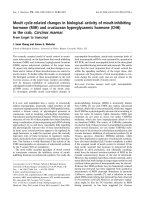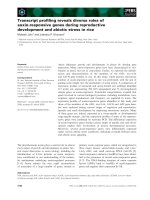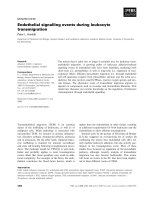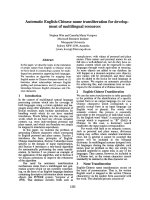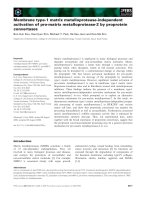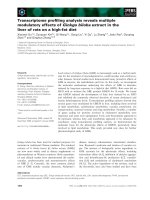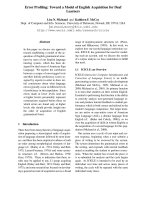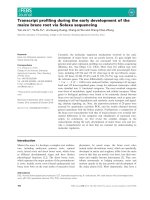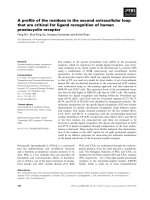Báo cáo khoa học: Transcript profiling during the early development of the maize brace root via Solexa sequencing pot
Bạn đang xem bản rút gọn của tài liệu. Xem và tải ngay bản đầy đủ của tài liệu tại đây (183.86 KB, 11 trang )
Transcript profiling during the early development of the
maize brace root via Solexa sequencing
Yan-Jie Li*, Ya-Ru Fu*, Jin-Guang Huang, Chang-Ai Wu and Cheng-Chao Zheng
State Key Laboratory of Crop Biology, College of Life Sciences, Shandong Agricultural University, China
Introduction
Maize (Zea mays L.) develops a complex root architec-
ture, including embryonic primary roots, seminal
roots, lateral roots and shoot borne roots, which form
at different developmental stages and have distinct
physiological functions [1,2]. The shoot borne roots,
which represent the major portion of the postembryon-
ic roots, include crown roots formed underground and
brace roots born on the stem nodes of successive basal
phytomers. In cereal crops, the brace roots (also
termed nodal adventitious roots), which are specifically
developed in maize and sorghum, differ from the main
roots in that they are mostly very short, lose their mer-
istem and rapidly become determinate [3]. They con-
tribute enormously to lodging resistance, water and
nutrient uptake in the late growth and development of
the maize plants [4,5]. Most importantly, they have a
Keywords
brace root; differential expression; maize;
Solexa sequencing; tag
Correspondence
C C. Zheng or C A Wu,
College of Life Sciences, Shandong
Agricultural University, Taian, Shandong
271018, China
Fax: +86 538 8226399
Tel: +86 538 8242894; +86 538 8246678
E-mail: ;
*These authors contributed equally to this
work
(Received 16 September 2010, revised 19
October 2010, accepted 26 October 2010)
doi:10.1111/j.1742-4658.2010.07941.x
Currently, the molecular regulation mechanisms involved in the early
development of maize brace root are poorly known. To gain insight into
the transcriptome dynamics that are associated with its development,
genome-wide gene expression profiling was conducted by Solexa sequencing
(Illumina Inc., San Diego, CA, USA). More than five million tags were
generated from the stem node tissues without and with just-emerged brace
roots, including 149 524 and 178 131 clean tags in the two libraries, respec-
tively. Of these, 82 864 (55.4%) and 91 678 (51.5%) tags were matched to
the reference genes. The most differentially expressed tags with a log
2
ratio
> 2 or < )2(P < 0.001) were analyzed further, representing 143 up-regu-
lated and 152 down-regulated genes, except for unknown transcripts, which
were classified into 11 functional categories. The most enriched categories
were those of metabolism, signal transduction and cellular transport. Many
genes or biological pathways were found to be commonly shared between
brace root and lateral or adventitious root development, such as genes par-
ticipating in cell wall degradation and synthesis, auxin transport and signal-
ing, ethylene signaling, etc. Next, the expression patterns of 20 genes were
assessed by quantitative real-time PCR, and the results obtained showed
general agreement with the Solexa analysis. Furthermore, a comparison of
the brace root transcriptome with that of maize primary root revealed sub-
stantial differences in the categories and abundances of expressed tran-
scripts. In conclusion, we first reveal the complex changes in the
transcriptome during the early development of maize brace root and pro-
vide a comprehensive set of data that are essential for understanding its
molecular regulation.
Abbreviations
DGE, Illumina ⁄ Solexa digital gene expression; EST, expressed sequence tag; N, node tissues; NR, node tissues with just-emerged brace
roots; qRT-PCR, quantitative real-time PCR; TPM, transcript per million.
156 FEBS Journal 278 (2011) 156–166 ª 2010 The Authors Journal compilation ª 2010 FEBS
substantial influence on grain yield under soil flooding
and water-limited conditions [6].
In the past decades, research on the maize brace
roots has been focused mainly at the morphological
and physiological levels. It has been well described that
the primordia of brace roots develop from dedifferenti-
ated cells of the stem parenchyma, just behind the stem
cortex and below the intercalary meristem of the over-
laying internodes [7]. Previous studies have demon-
strated that many nutritional or environmental factors
could affect brace root formation. Demotes-Mainard
and Pellerin [8] reported that the number of brace
roots emerging from the upper phytomers was lower
when the carbohydrate nutrition of plants was reduced
by shading or low light as a result of large plant densi-
ties. Nutrient deficiencies such as phosphorus and
nitrogen could decrease the rate of emergence or the
number of brace roots [9,10]. Soil ridging is also an
important factor that could increase the number of
functional brace roots, and later ridging tends to result
in shorter internodes and more functional nodal roots,
leading to better lodging resistance [11,12]. However,
to date, knowledge concerning their initiation or early
development at the molecular level remains poor, and
only the RTCS gene encoding a LOB domain protein
was suggested to be a potential regulator of the maize
crown and brace root initiation [13–15]. Recently, sev-
eral genes involved in regulating the development of
other root types of maize have been identified. The
SLR1 and SLR2 genes were reported to be required
for lateral root elongation [16]. Ten ZmGSL members
in the gibberellic acid stimulated-like gene family were
found to be involved in modulating the lateral root
development [17]. The rum1 and lrt1 mutants failed to
develop lateral roots [18]. In addition, the rth1 mutant,
which is deficient in encoding a subunit of the exocyst
complex, exhibited a reduction in root hairs [19]. Some
possible regulatory genes involved in the lateral or
adventitious root formation of Arabidopsis, rice and
Pinus contorta were also proposed [20–23]. Therefore,
it is interesting to determine whether the maize brace
root formation shares the same regulatory mechanisms
with these underground roots. To obtain a comprehen-
sive and unbiased transcript profile during maize brace
root formation, we performed deep sequencing analysis
using the Illumina ⁄ Solexa digital gene expression
(DGE) system. The DGE system is an improved tag-
based method that can sequence in parallel millions of
DNA molecules that are derived directly from mRNA
[24]. The development of the DGE system enables the
sequencing of total cDNA for the derivation of an
accurate measure of gene expression, both individually
and comprehensively, and the discovery of novel
regions of transcription, dramatically changing the
way that the functional complexity of transcriptome
can be studied.
In the present study, an overall impression of gene
profiles during the early development of the maize
brace root was acquired by deep sequencing. For the
first time, we have comprehensively characterized the
molecular basis of the physiological processes during
maize brace root formation and provide useful infor-
mation for further research.
Results
Characterization of the sequenced Solexa
libraries
To identify genes involved in brace root initiation, two
maize Solexa libraries were constructed from tissues of
node and node with just-emerged brace roots.
Sequencing depths of 4 172 448 and 5 713 648 tags
were achieved in the two libraries, including 328 043
and 432 881 distinct tags, respectively. To make the
libraries meaningful, tags recorded only once were first
wiped off as a result of their unreliability; leaving
149 524 and 178 131 distinct tags in each library that
were detected multiple times (clean tags). The fre-
quency of these tags is shown in Table 1, which lists
the copy numbers in the range 2–100 or higher, in
which the majority of clean tags (68% from each) were
present at low copy numbers (< 10 copies), and
approximately 26% tags from each library were
counted between 11 and 100 times. Only approxi-
mately 5% tags were detected more than 100 times.
To identify the genes corresponding to the 149 524
and 178 131 meaningful tags in each library, an essential
dataset containing 163 919 reference genes expressed in
the maize genome from the MaizeSequence database
( was prepared by
Table 1. Distribution of the experimental tags sequenced from the
two solexa libraries.
NNR
Total number of tags 4 172 448 5 713 648
Total number of distinct tags 328 043 432 881
Tag copy number > 1 (clean tag) 149 524 178 131
2–5 79 592 96 393
6–10 22 284 25 215
11–20 16 804 19 180
21–50 15 997 17 867
51–100 7316 9088
> 100 7531 10 388
Y J. Li et al. Solexa profiles of maize brace roots
FEBS Journal 278 (2011) 156–166 ª 2010 The Authors Journal compilation ª 2010 FEBS 157
expressed sequence tag (EST) analysis. Altogether,
144 768 genes (88.3%) have the CATG sites, resulting in
a total number of 1 417 555 reference tags. By assigning
the experimental Solexa tags to the virtual reference
ones (Table 2), we observed that 68 639 (45.9%) and
71 250 (40%) tags were perfectly matched to the refer-
ence genes in node tissues (N) and node tissues with
just-emerged brace roots (NR) libraries respectively.
Out of the tags matched to reference genes, approxi-
mately 13% were mapped to multiple locations, includ-
ing low complexity tags with poly(A) tails and tags
derived from repetitive sequences. Further sequences
analysis revealed that some of them were mapped to
highly conserved domains shared by different genes. For
example, CATGGACAAGTTCGGCGGCGT could be
matched to AC194430.3_FG026 and AC194430.3_
FG036 sharing a 792 bp sequence encoding a fatty acid
hydroxylase domain. In addition, approximately 14%
tags in two libraries were mapped to the antisense
strands, demonstrating that those regions might be bidi-
rectionally transcribed. However, for the discrepancy
between the reference tags and experimental tags [25],
10% of 1 bp mismatched tags were present in the two
libraries.
Altogether, there are 82 864 (55.4%) tags in the N
library and 91 678 (51.5%) tags in the NR library
matched to the reference genes. The unmatched tags
were then blasted against the maize genome, and
approximately 31% tags were matched to the genomic
sequences in the two libraries. These might represent
non-annotated genes or noncoding transcripts that
derived from intergenic regions. As a result of the sig-
nificant sequencing depth of Solexa technology and
incomplete annotation of the maize genome, however,
13.7% and 15.7% unmatched tags in each library were
observed.
Identification of differentially expressed
transcripts
By comparing our two Solexa libraries, a great number
of differentially expressed transcripts were identified.
The distribution of fold-changes in tag number between
the two libraries is shown in Fig. S1. The great major-
ity of transcripts were expressed at similar levels in the
two libraries: approximately 98.6% tags showed a < 5-
fold difference in expression. Tags with expressional
changes in the range 5–200-fold accounted for 1.39%,
and only 0.01% tags showed > 200-fold changes in
expression level. At a statistically significant value
(P < 0.01), 7239 differentially expressed tags exhibiting
substantial changes were detected, including 3720 anno-
tated genes (51%). Scatter plot analysis also presented
a broader scope of differentially expressed tags than
annotated genes, demonstrating that a great number of
unknown transcripts were revealed (Fig. S2). To study
a subset of genes that were associated with brace root
development and to assess the molecular basis of brace
root development, we analyzed the most differentially
regulated tags with a log
2
ratio > 2 or < )2 using a
greater statistically significant value (P < 0.001) as well
as false discovery rates (FDR < 0.01), representing
307 up-regulated and 372 down-regulated transcripts.
Apart from the unknown transcripts (55%), predicted
or known genes were categorized according to their
functions. Altogether, 143 up- and 152 down-regulated
genes were listed and classified into 11 categories
(Tables 3 and S1). Of these, the most enriched func-
tional categories are those of metabolism (19.6%), sig-
naling pathway (12.8%) and cellular transport (12.6%).
Gene categories showed an obvious increase in tran-
script abundance involved in protein binding and cell
wall metabolism. By contrast, transcriptional abun-
dance for genes participating in transcript regulation,
cell cycle and DNA replication pathways were reduced.
At the cellular level, brace root initiation involves
two major steps similar to that of lateral or adventi-
tious roots: the degradation of overlaying cells and the
reorganization of new root cells, which are regulated
by auxin associated networks [23]. In total, 25 differen-
tially expressed genes involved in cell wall metabolism
and cell morphogenesis were listed (Table S1). Nine
transcripts encoding endoglucanase, pectin lyase and
chitinase genes, which were involved in cell wall degra-
dation, were greatly up-regulated. On the other hand,
another 10 genes directly participating in cell wall bio-
synthesis and cell morphogenesis were obviously
induced as well, such as xyloglucan fucosyltransferase,
cellulose synthase, COBRA and expansin. Interestingly,
many auxin associated genes were also differentially
Table 2. Summary of Solexa distinct tag-to-gene mapping data.
Tag mapping
Distinct tags
NNR
Sense
Perfect match 59 802 (40%) 62 276 (35%)
bp mismatch 12 241 (8.1%) 17 852 (10%)
Antisense
Perfect match 8837 (5.9%) 8974 (5%)
1 bp mismatch 1984 (1.3%) 2576 (1.4%)
All tags mapping to gene 82 864 (55.4%) 91 678 (51.5%)
Tags mapping to genome 46 247 (30.9%) 58 430 (32.8%)
No matched tags 20 413 (13.7%) 28 023 (15.7%)
Total distinct tags
(clean tags)
149 524 178 131
Solexa profiles of maize brace roots Y J. Li et al.
158 FEBS Journal 278 (2011) 156–166 ª 2010 The Authors Journal compilation ª 2010 FEBS
regulated in the present study, such as AUX, ARF,
H+ pyrophosphatase, P450 CYP81A and ABC trans-
porters (Table S1). In accordance with previous studies
[22,26], the AUX gene was sharply induced and two
ARF proteins were greatly decreased in the present
analysis, which could positively regulate brace root
development.
In addition, it was observed that many gene families
were over-represented in the data of the present study
(Table S1). For example, six transcripts encoding
members of major facilitator super family were classi-
fied into cellular transport categories, and five of them
are down-regulated in the NR library. The most abun-
dant gene family present is the protein kinase family;
16 genes out of the total 24 members were significantly
induced in the NR library, implying the importance of
signal transduction during the early brace root devel-
opment. The over-representation of the same family
members strongly suggests their regulating roles in this
developmental transition processes.
Furthermore, with the benefit of Solexa sequencing
(i.e. meaning that the entire transcriptome is surveyed),
numerous novel transcripts with an unclear function
were also detected (Table S2).
Quantitative quantitative real-time PCR
(qRT-PCR) confirmation
To evaluate the validity of Solexa analysis and to
further assess the patterns of differential gene expres-
sion, 20 candidate genes were selected and detected
by qRT-PCR, including two unknown transcripts
AC211140.2_FG010 and AC209357.3_FG031 (Table S2).
As shown in Table 4, the expression patterns showed
general agreement with the Solexa sequencing. Because
of the apparent discrepancies with respect to ratio, it
should be attributed to the essentially different algo-
rithms determined by the two techniques [27]. In the
analysis of gene profiles, the deep sequencing method
generates absolute rather than relative expression mea-
surements. As expected, transcripts from highly abun-
dant Solexa tags appeared at the expected lower cycle
numbers in the quantitative PCR analyses. Addition-
ally, high-fold changes were observed for genes that
showed low copy numbers in the N library but high
abundances in the NR library. For example, PI12
showed no expression in the N library, whereas it was
detected 230 times in the NR library. It was signifi-
cantly up-regulated by 166.7-fold in the RT-PCR
analysis. Similarly, a b-1,3-glucanase-like gene was
induced by 62-fold. These results basically confirmed
the reliability of our transcriptome analysis.
To further investigate the expression profiles of
these genes, stem node tissues were harvested from
separate successive phytomers of the V6 stage maize,
representing four different developmental phases of
brace roots: pre-initiation, initiation, emergence and
post-emergence (Fig. 1A). From the qRT-PCR results
(Fig. 1B), altered expression was observed for all the
candidate genes, indicating that they were involved in
the regulatory networks during brace root formation.
GRP (glycine-rich cell wall structural protein), PI 12
(proteinase inhibitor I 12), PI 13 (proteinase inhibitor
I 13), BGL (B-1,3-glucanase like), Chn1 (Chitinase)
and ABC transporter gene were up-regulated, whereas
E3, AC209357.3_FG031 and AC211140.2_FG010
genes were down-regulated as the brace root devel-
ops, indicating that these genes play positive or
negative roles during both brace root initiation and
later development. Other genes such as expansin, XF
(xyloglucan fucosyltransferase), CesA (cellulose syn-
thase), NOI (nitrogen transporter) and CYP 81A
Table 3. Functional classification of genes differentially expressed during the early development of the maize brace root.
Functional category
Number (proportion)
Up-regulated Down-regulated Total
Cell wall metabolism 15 (5.1%) 6 (2%) 21 (7.1%)
Cell morphogenesis 4 (1.3%) 0 (0) 4 (1.3%)
Signaling pathway 23 (7.8%) 15 (5%) 30 (12.8%)
Cell replication 1 (0.3%) 18 (6.1%) 19 (6.4%)
Epigenetic modulation 1 (0.3%) 3 (1%) 4 (1.3%)
Environmental response 22 (7.5%) 12 (4.1%) 34 (11.6%)
Ion uptake and cellular transport 12 (4.1%) 25 (8.5%) 37 (12.6%)
Transcription regulation 8 (2.7%) 22 (7.5%) 30 (10.2%)
Metabolism 29 (9.8%) 29 (9.8%) 58 (19.6%)
Protein synthesis, protein fate and function regulation 11 (3.7%) 14 (4.7%) 25 (8.4%)
Protein binding function 17 (5.7%) 8 (2.7%) 25 (8.4%)
Total 143 (48.3%) 152 (51.7%) 295 (100%)
Y J. Li et al. Solexa profiles of maize brace roots
FEBS Journal 278 (2011) 156–166 ª 2010 The Authors Journal compilation ª 2010 FEBS 159
were first induced to a high expression level and then
decreased, indicating that they might play major roles
in specific developmental stages. Moreover, the
expression of ARF, two DNA methyltransferases and
HMG fluctuated during brace root development,
demonstrating that these genes might be regulated in
a temporal manner.
Comparison of the maize brace root and primary
root transcript profiles
To determine the differentially expressed transcripts
involved in the maize brace root and primary root
development, we compared the 80 most highly abun-
dant brace root transcripts in the NR library
(Table S3) and the primary root transcripts reported
by Poroyko et al. [28]. The results obtained revealed
that the selected tags in brace root and primary root
showed little overlap in functional category or tran-
script identity. Functional analysis of the 80 abundant
brace root transcripts revealed that a large proportion
of them are enzymes involved in the metabolic and
energy processes, such as glutathione S-transferase,
glycoside hydrolase and dTDP-glucose dehydratase,
indicating that these metabolic processes are more
active in the early development of brace roots. More-
over, as shown in Table 5, comparison of gene catego-
ries showed that, except for the categories of
chromatin structure and energy production, substantial
differences were observed. For example, in the maize
primary root tissue, the most abundant genes were
involved in translation and ribosome structure, which
accounted for 24% of genes, whereas only 11.3% of
genes were classified into this category in the brace
root tissue. For the rest of the categories, the tran-
script abundances in the brace root were higher than
that in the primary root. In the 55 annotated tags in
the primary root reported by Poroyko et al. [28], 19
tags showed no match to any transcript in our NR
libraries, suggesting that these genes were not
expressed in brace root tissue. Thirty-one tags, as a
result of being only 14 nucleotides in length, were
mapped to more than one brace root tag (21 nucleo-
tides). Only five transcripts were present in both
libraries, encoding a initiation factor 5A, elongation
factor 1-b, 60S ribosomal protein L5, ribosomal pro-
tein S10 and calmodulin, respectively (Table 6). The
obvious discrepancies between the two root expression
profiles imply that different regulation mechanisms are
involved in maize brace root and primary root early
development.
Discussion
The major goal of the present study is to preliminarily
explore transcripts involved in the early development
Table 4. Confirmation of the expression profiles of selected genes by qRT-PCR.
Gene ID Description
Solexa
qRT-PCR NR ⁄ N
b
NNRNR⁄ N
a
AC196718.3_FG011 Glycine-rich cell wall protein 6 33 5.5 9.09
AC186025.4_FG038 Endochitinase A 2 2391 9.77 21.21
AC210802.2_FG026 Cellulose synthesis 139 778 5.60 1.66
AC213625.3_FG012 Chitinase, Chn1 0 19 19 2.38
AC190604.1_FG019 Xyloglucan fucosyltransferase 0 16 16 250
AC196105.3_FG035 b1,3-glucanase like 0 51 51 62.31
AC204864.2_FG012 Expansin 0 25 25 16.7
AC207722.2_FG007 Peptidoglycan-binding LysM 366 82 0.22 0.49
AC186904.4_FG033 Ubiquitin-conjugating enzyme E3 22 4 0.18 0.37
AC202436.3_FG030 CYP81A 0 21 21 67
AC191413.2_FG016 Auxin response factor 49 8 0.16 0.34
AC203442.2_FG039 ABC transporter 0 18 18 3.2
AC196047.2_FG033 Nitrate-induced NOI, related to nitrate transport 0 36 36 1.78
AC205343.2_FG019 MCM protein 5 8 0 0.13 0.40
AC194119.3_FG024 Sugar transporter 0 16 8.19 4.72
AC204716.3_FG005 DNA cytosine methyltransferase MET2a 13 0 0.07 0.51
AC190984.3_FG038 Proteinase inhibitor I12 0 231 231 166.7
GRMZM2G077244 Proteinase inhibitor I13 0 59 59 150
AC211140.2_FG010 Unknown 55 9 0.16 0.45
AC209357.3_FG031 Unknown 77 16 0.21 0.2
a
To avoid division by 0, we used a tag value of 1 for any tag that was not detected in any sample.
b
Ratio of relative concentrations.
Solexa profiles of maize brace roots Y J. Li et al.
160 FEBS Journal 278 (2011) 156–166 ª 2010 The Authors Journal compilation ª 2010 FEBS
of the maize brace root, as well as to provide ground-
work for investigating their regulating mechanisms. To
our knowledge, this is the first report that comprehen-
sively shows the transcriptional changes during the
onset of brace root branching. We used the Illu-
mina ⁄ Solexa DGE system, which is essentially a serial
analysis of gene expression-based tag profiling
approach. Several previous studies for the plant pri-
mary and lateral root transcript profiles using deep
sequencing have been reported [25,27–29]. Fizames
et al. [25] investigated root transcriptome responses to
2,4,6-trinitrotoluene exposure in Arabidopsis. Poroyko
et al. [28] defined the number and abundance of tran-
scripts in the root tip of the maize seedlings. In the
present study, a sequencing depth of more than five
million tags was finally achieved, which was increased
by approximately 25-fold compared to maize primary
root transcript profiling [28]. Recently, Wang et al. [29]
revealed the epigenetic modifications in maize shoots
and roots by Solexa sequencing, demonstrating that
Solexa sequencing analysis has emerged as an efficient
and economical method for sampling transcript
P1
P2
P3
P4
XF
P1
P2
P3
P4
GRP
BA
P1
P2
P3
P4
P1
P2
P3
P4
AC209357.3_FG031
P1
P2
P3
P4
P1
P2
P3
P4
P1
P2
P3
P4
P1
P2
P3
P4
PI12
P1
P2
P3
P4
E3
P1
P2
P3
P4
Expansin
P1
P2
P3
P4
P1
P2
P3
P4
Chn1
LysM
P1
P2
P3
P4
ABC transporter
MET
P1
P2
P3
P4
NOI
CesA
P1
P2
P3
P4
AC211140.2_FG010
Endochitinase A
P1
P2
P3
P4
P1
P2
P3
P4
ARF
Sugar transporter
P1
P2
P3
P4
PI13
P1
P2
P3
P4
BGL
P1
P2
P3
P4
CYP81A
P1
P2
P3
P4
0 5 10 15 20 25
0 0.2 0.4 0.6 0.8 1 1.2 0 0.2 0.4 0.6 0.8 1 1.2
0123456
0 0.2 0.4 0.6 0.8 1 1.2
0 3 6 9 12 15
0 0.5 1 1.5 2 2.5
0 0.3 0.6 0.9 1.2 1.5
0 0.2 0.4 0.6 0.8 1 1.2
0 0.3 0.6 0.9 1.2 1.5
0 0.4 0.8 1.2 1.6 2
0 0.4 0.8 1.2 1.6 2
0 3 6 9 12 15
0 0.3 0.6 0.9 1.2 1.5
00.551.522.53
0 0.4 0.8 1.2 1.6 2 2.4
0 0.2 0.4 0.6 0.8 1 1.2
0 0.2 0.4 0.6 0.8 1 1.2
0 1020304050
0 0.2 0.4 0.6 0.8 1 1.2
MCM
Fig. 1. The expression profiles of 20 selected genes in different developmental stages of the maize brace roots. (A) Schematic drawings
illustrating different developmental stages of the maize brace root in different phytomers. P1, P2, P3 and P4 represent the first, second,
third and fourth phytomer, respectively. (B) Relative expression of the 20 genes detected by qRT-PCR in different phytomers. The transcript
levels were normalized to that of elongation factor 1-a, and the level of each gene in the first phytomer (P1) was set at 1.0. Error bars repre-
sent the SE for three independent experiments. GRP (glycine-rich cell wall structural protein), endochitinase A, CesA (cellulose synthesis),
Chn1 (chitinase chem5), XF (xyloglucan fucosyltransferase), BGL (b1,3-glucanase like), expansin, LysM (peptidoglycan-binding LysM), E3
(ubiquitin-conjugating enzyme E3), CYP 81A (cytochrome P450 81A), ARF (auxin response factor), ABC transporter, NOI (nitrate-induced
NOI, correlated to nitrate transport), MCM (MCM protein 5), sugar transporter, MET (DNA cytosine methyltransferase MET2a), PI13 (protein-
ase inhibitor I13), PI12 (proteinase inhibitor I12) (Table S1), AC211140.2_FG010, AC209357.3_FG031 (Table S2).
Y J. Li et al. Solexa profiles of maize brace roots
FEBS Journal 278 (2011) 156–166 ª 2010 The Authors Journal compilation ª 2010 FEBS 161
profiles under specific experimental conditions. Gener-
ally, a significant sequencing depth would greatly help
to explore clean tags that were detected more than
once. In the present study, the clean tags and the sin-
gletons accounted for approximately 43% and 57% in
the two Solexa libraries. However, a total of 40 599
different tags were sequenced in the maize primary
root tissues, of which 63.5% tags were singletons [28].
Furthermore, 84% tags in the wheat grain tissues were
singletons [30]. These data suggest that, as the sequenc-
ing depth increases, the proportion of clean tags will
also increase.
A crucial step in deep sequencing studies is the
annotation of the tags. In the present study, we gener-
ated a 21 bp tag for mapping to the existing tran-
scripts data, which is more specific than the 14 or
19 bp tags emploted in previous serial analyses of gene
expression [25,27,31]. In total, we could map approxi-
mately 85.3% of tags to unique or non-unique posi-
tions, which is the same proportion as that described
by Wang et al. [29], demonstrating that Illumina⁄ So-
lexa sequencing and tag mapping are feasible with
great accuracy in large and repeat-rich maize genomes.
However, these approaches still suffer limitations in
the reference gene databases. In the present study, only
88.3% of reference genes from the maize EST library
have the CATG sites, leaving 19 151 genes unanalyzed,
which means that a number of the related genes
involved in brace root initiation would be neglected.
For example, because of the absence of CATG in the
EST sequence, we did not detect tags representing the
RTCS gene, which was reported to be involved in con-
trolling brace root development [15].
Solexa sequencing could provide a comprehensive
and unbiased dataset in the global analysis of gene
expression. Recently, Zenoni et al. [32] profiled the
Table 5. Comparison of the functional categories of the 80 most
abundant tags in the maize brace root and primary root tissues.
Functional category
% maize
brace root
% maize
primary root
Translation, ribosome structure 11.3 24
Transcription 6.3 0.8
Chromatin structure 1.3 1.6
Energy production and conversion 3.8 4
Carbohydrate transport and
metabolism
8.8 4
Lipid transport and metabolism 3.8 1.6
Cell wall ⁄ membrane ⁄ envelope
biogenesis
3.8 0.8
Signal transduction 1.3 0.8
Ion transport 2.9 1.6
Defense mechanisms 1.3 0
Table 6. The common transcripts present in both maize brace root and primary root.
Tag
Maize root Maize brace root
Copy
number
Abundance
(%) Maize EST Tag
Copy
number
Abundance
(%) Gene Gene description
CATGTGAACCGTAC 55 0.0335 CF636407 CATGTGAACCGTACTGAGTAT 996 0.0174 AC191267.3_FG009 Initiation factor 5A
CATGCTGCCATCCG 35 0.0213 CF636691 CATGCTGCCATCCGTGCTGAT 95 0.0017 AC219023.2_FG021 60S ribosomal protein L5
CATGATGACCATCG 28 0.017 CF637384 CATGATGACCATCGTCGACGA 3969 0.0695 AC195599.3_FG034 Elongation factor 1-b,
putative
CATGGGATCGGTTT 10 0.061 CF634223 CATGGGATCGGTTTGAGTTCC 279 0.0049 AC225796.1_FG024 Ribosomal protein S10
CATGATCAACGAGG 3 0.0018 CF636639 CATGATCAACGAGGTCGATGC 150 0.0026 AC203677.3_FG029 Calmodulin
Solexa profiles of maize brace roots Y J. Li et al.
162 FEBS Journal 278 (2011) 156–166 ª 2010 The Authors Journal compilation ª 2010 FEBS
patterns of gene expression during plant developmental
transition in Vitis vinifera , and a wide range of tran-
scriptional responses associated with berry develop-
ment were investigated, demonstrating that the plant
developmental transition is a complex process that
requires the regulation of many transcripts [32,33]. In
the present study, 7239 differentially expressed anno-
tated and novel transcripts (P < 0.01) were explored.
Except for unknown transcripts, the most differentially
expressed genes with a log
2
ratio > 2 or < )2(P <
0.001) also participate in various biological pathways,
such as cell wall metabolism, signal transduction, envi-
ronmental response and transcription regulation. Inter-
estingly, many transcripts detected at very low copy
numbers in the control library (N) were significantly
up-regulated in the NR library (Table S1), implying
that these genes might be specifically expressed in
brace root tissues. For example, the presence of sugar
transporter and potassium uptake channel genes in the
NR library rather than the N library indicates that the
emerged brace roots begin to take on new functions
with respect to ion uptake or nutrient transport.
Previous studies have reported the transcript profiles
of P. contorta adventitious root development and Ara-
bidopsis lateral root development by microarray analy-
sis [20,21]. A large number of differentially expressed
genes involved in critical pathways during the lateral
or adventitious root development were also found in
the present study, such as genes participating in cell
wall degradation and synthesis, auxin transport and
signaling. In Arabidopsis, P450 CYP83A1, CYP83B1,
CYP79B2 and CYP79B3 were previously reported to
act as key enzymes in the auxin biosynthesis pathway
[34,35]. We proposed that the sharp increase of tran-
script encoding the P450 CYP81A might be required
for auxin biosynthesis during maize brace root pattern-
ing, indicating that auxin represents a regulator in
both brace root and lateral or adventitious root devel-
opment in higher plants [20,23,36,37]. In addition,
blocking ethylene responses by etr1 (ethylene triple
response1) or ein2 (ethylene insensitive 2) mutation
was reported to increase lateral root formation in Ara-
bidopsis [38]. We observed that an EIN3 (ethylene-
insensitive 3) gene was markedly decreased in the NR
library (Table S1), implying that ethylene signaling was
also negatively involved in brace root development. In
addition, a large number of transcripts involved in
wound, pathogen or disease defenses were significantly
induced, including proteinase inhibitors, disease resis-
tance proteins and pathogenesis-related genes, etc.,
which is also observed in P. contorta adventitious root
development [20]. We thus propose that these tran-
scripts might be also induced by the break up of
tissues during the emergence of the brace root from
the stem node, which in turn contributes to a defensive
barrier against extrinsic biotic intrusion. Taken
together, some regulating mechanisms appear to be
commonly shared with respect to maize brace root and
plant lateral or adventitious root formation.
Although numerous nomatched or unknown tags
were detected, the value of this tag collection will
increase as more maize genomic sequences become
available. Further functional analysis of the differen-
tially expressed genes will provide deeper insight into
the regulation of maize brace root development.
Materials and methods
Plant material and RNA extraction
The maize (Zea mays) inbred line H5468 was used in the
present study. Seeds of H5468 were surface-sterilized with
3% sodium hypochlorite for 10 min and rinsed in distilled
water. Sterilized seeds were pre-germinated on moistened
filter papers in a plant growth chamber at 60% humidity
and 28 °C, under a 16 : 8 h light ⁄ dark cycle for 3 days.
Then, the seedlings were transferred into the field in a
greenhouse and cultivated at a mean temperature of 28 °C
with both natural light and an additional 16 : 8 h light ⁄
dark cycle. For solexa analysis and qRT-PCR verification,
plants were harvested when they are at the V4 (four-leaf
stage) or V6 (six-leaf stage) stages (en
sion.iastate.edu/hancock/info/corn.htm). Each sample was
derived from at least five independent plants and the tissues
were mixed together. The transverse section of stem node
tissues at the first aboveground phytomer (from the bottom
to the top) of the V4 stage maize with no brace root initia-
tion were harvested as the control (N), and the same loca-
tion stem node tissues of the V6 stage where the brace
roots just emerge were sampled as NR (i.e. node tissue with
just-emerged brace roots). For analysis of the different
developmental phases, the transverse sections of the stem
node tissues at the first, second, third and fourth above-
ground phytomers were harvested from at least five inde-
pendent plants of V6 stage. All samples were immediately
frozen in liquid nitrogen. Then, total RNA were prepared
from 0.1 g tissues and extracted with Trizol Reagent (Invi-
trogen, Carlsbad, CA, USA) in accordance with the manu-
facturer’s instructions.
Tag library construction and sequencing
For Solexa tag preparation and sequencing, 1 lg of total
RNA was incubated with oligo(dT) beads to capture the
mRNA with a poly(A) tail. First- and second-strand cDNA
was synthesized and bead-bound cDNA was subsequently
digested with NlaIII. The GEX adapters 1 containing a
Y J. Li et al. Solexa profiles of maize brace roots
FEBS Journal 278 (2011) 156–166 ª 2010 The Authors Journal compilation ª 2010 FEBS 163
restriction site for MmeI were ligated to the free 5¢ ends of
the digested bead-bound cDNA fragments. Then, the bead-
bond fragments were digested with MmeI, which could cut
17–18 bp downstream of the CATG site (NlaIII site),
releasing 21–22 bp tags starting with the NlaIII recognition
sequence. A second adaptor (GEX adaptor 2) was ligated
at the site of MmeI cleavage, and the adapter-ligated cDNA
tags were enriched using PCR primers that anneal to the
adaptor ends. The resulting PCR fragments were purified
from a 6% acrylamide gel and subjected to the Illu-
mina ⁄ Solexa sequencing system (Illumina Inc., San Diego,
CA, USA) using a sequencing-by-synthesis method in
accordance with the manufacturer’s instructions.
Tag-to-gene assignment and functional
categorization
Sequencing quality evaluation and data summarization were
performed using Illumina ⁄ Solexa pipeline software after
sequencing. For tag-to-gene assignment, soap (Short Oligo-
nucleotide Alignment Program) was used, allowing no more
than one base mismatch [39]. The schematic overview of the
procedure is given in Fig. S3. Reference ESTs or cDNA
sequences represented by bacteria artificial chromosomes
were obtained from the MaizeSequence database, release
3b.50 ( The experimen-
tal tags were first filtered to eliminate unauthentic ones and
to leave the clean tags for mapping to the reference tags
derived from cDNA or EST sequences, and the unmatched
ones were then blasted against the maize genome sequences.
For those sequenced tags, their expressional abundances in
each library were shown by copy numbers in the library. For
differential expression analysis, the fold changes were
assessed by the log
2
ratio (TPM-NR ⁄ TPM-N) after the
expressional abundances in each library were normalized to
transcript per million (TPM), which is accordance with the
study of Audic and Claverie [40]. After tag-to-gene assign-
ment, genes were grouped into functional categories based
on the MIPS Functional Catalogue Database (http://mips.
gsf.de), which was developed for the functional description
of proteins. The presence of identified functional domains by
blastx search in the examined sequence was accepted for the
assignment of functions. A criterion of sequence similarity
E-value < 1 · 10
)5
was used for the significant hits. Func-
tional categorization was carried out in the same way and
included a blast search against the Arabidopsis protein
database at TAIR ( />and the rice protein database ( The
search results were linked to the MIPS Functional Catalogue
Database for further functional categorization.
Real-time PCR
Reverse transcription reactions were performed using 5 lg
of RNA by M-MLV reverse transcriptase (Takara Bio Inc.,
Otsu, Japan) in accordance with the manufacturer’s instruc-
tions after incubation with RNase-free DNase I. For real-
time PCR, selected gene sequences were obtained from the
MaizeSequence database. Primers were designed using bea-
con designer 7.0 software (Premier Biosoft International,
Palo Alto, CA, USA). Elongation factor 1-a was used as
the inner control. The PCR primers are shown in Table S4.
Real-time PCR reactions were performed with a Bio-Rad
real-time thermal cycling system (Bio-Rad, Hercules, CA,
USA) using SYBR-Green to detect gene expression abun-
dances. The reaction mixture (25 lL) contained 0.5 lm of
each primer and the appropriate amounts of enzymes,
cDNA and fluorescent dyes. All runs used a negative con-
trol without adding target cDNA, resulting in no detectable
fluorescence signal from the reaction. A range of five dilu-
tions of the total cDNA was tested under the same condi-
tions as the samples. Amplification reactions were initiated
with a pre-denaturing step at 95 °C for 10 s and followed
by denaturing (95 °C for 5 s), annealing (60 °C for 10 s)
and extension (72 °C for 15 s) steps for 49 cycles during the
second stage, and a final stage of 55 °Cto95°C to deter-
mine dissociation curves of the amplified products. All reac-
tions were performed with at least three replicates. Data
were analyzed using Bio-Rad cfx manager software.
Acknowledgements
This work was supported by the National Natural
Science Foundation (grant numbers 30970225 and
30970230) and the Genetically modified organisms
breeding major projects (2009ZX08009-092B) in China.
References
1 Hochholdinger F, Park WJ, Sauer M & Woll K (2004a)
From weeds to crops: genetic analysis of root develop-
ment in cereals. Trends Plant Sci 9, 42–48.
2 Hochholdinger F, Woll K, Sauer M & Dembinsky D
(2004b) Genetic dissection of root formation in maize
(Zea mays) reveals root-type specific developmental pro-
grammes. Ann Bot 93, 359–368.
3 Varney GTMM (1991) The branch roots of Zea. II.
Developmental loss of the apical meristem in field-
grown roots. New Phytol 118, 535–546.
4 Varney GTCM (1993) Rates of water uptake into the
mature root system of maize plants. New Phytol 123,
775–786.
5 Wang XLMM & Canny MJ (1994) The branch roots of
Zea. IV. The maturation and openness of xylem con-
duits in first-order branches of soil-grown roots. New
Phytol 126, 21–29.
6 Hochholdinger F & Tuberosa R (2009) Genetic and
genomic dissection of maize root development and
architecture. Curr Opin Plant Biol 12, 172–177.
Solexa profiles of maize brace roots Y J. Li et al.
164 FEBS Journal 278 (2011) 156–166 ª 2010 The Authors Journal compilation ª 2010 FEBS
7 Hoppe DC, McCully ME & Wenzel CL (1986) The
nodal roots of Zea: their development in relation to
structural features of the stem. Can J Bot 64, 2524–
2537.
8 Demotes-Mainard S & Pellerin S (1992) Effect of
mutual shading on the emergence of nodal roots
and the root ⁄ shoot ratio of maize. Plant Soil 147,
87–93.
9 Pellerin S (1994) Number of maize nodal roots as
affected by plant density and nitrogen fertilization:
relationships with shoot growth. Eur J Agron 3,
101–110.
10 Sylvain Pellerin AM & Daniel Ple¢net (2000) Phosphorus
deficiency affects the rate of emergence and number of
maize adventitious nodal roots. Agronomy 92, 690–697.
11 Kaspar ALTaTC (1995) Maize nodal root response to
soil ridging and three tillage systems. Agron J 87, 853–
858.
12 Kaspar ALTaTC (1997) Maize nodal root response to
time of soil ridging. Agron J 89, 195–200.
13 Hochholdinger F & Zimmermann R (2008) Conserved
and diverse mechanisms in root development. Curr Opin
Plant Biol 11, 70–74.
14 Paszkowski U & Boller T (2002) The growth defect of
lrt1, a maize mutant lacking lateral roots, can be
complemented by symbiotic fungi or high phosphate
nutrition. Planta 214, 584–590.
15 Taramino G, Sauer M, Stauffer JL Jr, Multani D, Niu
X, Sakai H & Hochholdinger F (2007) The maize
(Zea mays L.) RTCS gene encodes a LOB domain pro-
tein that is a key regulator of embryonic seminal and
post-embryonic shoot-borne root initiation. Plant J 50,
649–659.
16 Hochholdinger F, Park WJ & Feix GH (2001) Coopera-
tive action of SLR1 and SLR2 is required for lateral
root-specific cell elongation in maize. Plant Physiol 125,
1529–1539.
17 Zimmermann R, Sakai H & Hochholdinger F (2010)
The gibberellic acid stimulated-like gene family in maize
and its role in lateral root development. Plant Physiol
152, 356–365.
18 Woll K, Borsuk LA, Stransky H, Nettleton D, Schnable
PS & Hochholdinger F (2005) Isolation, characteriza-
tion, and pericycle-specific transcriptome analyses of the
novel maize lateral and seminal root initiation mutant
rum1. Plant Physiol 139, 1255–1267.
19 Wen TJ, Hochholdinger F, Sauer M, Bruce W & Sch-
nable PS (2005) The roothairless1 gene of maize
encodes a homolog of sec3, which is involved in polar
exocytosis. Plant Physiol 138, 1637–1643.
20 Brinker M, van Zyl L, Liu W, Craig D, Sederoff RR,
Clapham DH & von Arnold S (2004) Microarray
analyses of gene expression during adventitious root
development in Pinus contorta. Plant Physiol 135, 1526–
1539.
21 Himanen K, Vuylsteke M, Vanneste S, Vercruysse S,
Boucheron E, Alard P, Chriqui D, Van Montagu M,
Inze D & Beeckman T (2004) Transcript profiling of
early lateral root initiation. Proc Natl Acad Sci USA
101, 5146–5151.
22 Inukai Y, Sakamoto T, Ueguchi-Tanaka M, Shibata Y,
Gomi K, Umemura I, Hasegawa Y, Ashikari M, Kit-
ano H & Matsuoka M (2005) Crown rootless1, which is
essential for crown root formation in rice, is a target of
an AUXIN RESPONSE FACTOR in auxin signaling.
Plant Cell 17, 1387–1396.
23 Peret B, Larrieu A & Bennett MJ (2009) Lateral
root emergence: a difficult birth. J Exp Bot 60 , 3637–
3643.
24 Morozova O & Marra MA (2008) Applications of
next-generation sequencing technologies in functional
genomics. Genomics 92, 255–264.
25 Fizames C, Munos S, Cazettes C, Nacry P, Boucherez
J, Gaymard F, Piquemal D, Delorme V, Commes T,
Doumas P et al. (2004) The Arabidopsis root transcrip-
tome by serial analysis of gene expression. Plant Physiol
134, 67–80.
26 Marchant A, Bhalerao R, Casimiro I, Eklof J, Casero
PJ, Bennett M & Sandberg G (2002) AUX1 promotes
lateral root formation by facilitating indole-3-acetic
acid distribution between sink and source tissues in the
Arabidopsis seedling. Plant Cell 14, 589–597.
27 Ekman DR, Lorenz WW, Przybyla AE, Wolfe NL &
Dean JF (2003) SAGE analysis of transcriptome
responses in Arabidopsis roots exposed to 2,4,6-trinitro-
toluene. Plant Physiol 133 , 1397–1406.
28 Poroyko V, Hejlek LG, Spollen WG, Springer GK,
Nguyen HT, Sharp RE & Bohnert HJ (2005) The maize
root transcriptome by serial analysis of gene expression.
Plant Physiol 138, 1700–1710.
29 Wang X, Elling AA, Li X, Li N, Peng Z, He G, Sun H,
Qi Y, Liu XS & Deng XW (2009) Genome-wide and
organ-specific landscapes of epigenetic modifications
and their relationships to mRNA and small RNA tran-
scriptomes in maize. Plant Cell 21, 1053–1069.
30 Poole RL, Barker GL, Werner K, Biggi GF, Coghill J,
Gibbings JG, Berry S, Dunwell JM & Edwards KJ
(2008) Analysis of wheat SAGE tags reveals evidence
for widespread antisense transcription. BMC Genomics
9, 475.
31 Byun YJ, Kim HJ & Lee DH (2009) LongSAGE analy-
sis of the early response to cold stress in Arabidopsis
leaf. Planta 229, 1181–1200.
32 Zenoni S, Ferrarini A, Giacomelli E, Xumerle L, Fasoli
M, Malerba G, Bellin D, Pezzotti M & Delledonne M
(2010) Characterization of transcriptional complexity
during berry development in Vitis vinifera using RNA-
Seq. Plant Physiol 152, 1787–1795.
33 Willenbrock H, Salomon J, Sokilde R, Barken KB,
Hansen TN, Nielsen FC, Moller S & Litman T (2009)
Y J. Li et al. Solexa profiles of maize brace roots
FEBS Journal 278 (2011) 156–166 ª 2010 The Authors Journal compilation ª 2010 FEBS 165
Quantitative miRNA expression analysis: comparing
microarrays with next-generation sequencing. RNA 15,
2028–2034.
34 Bak S, Tax FE, Feldmann KA, Galbraith DW &
Feyereisen R (2001) CYP83B1, a cytochrome P450 at
the metabolic branch point in auxin and indole gluco-
sinolate biosynthesis in Arabidopsis. Plant Cell 13,
101–111.
35 Zhao Y, Hull AK, Gupta NR, Goss KA, Alonso J,
Ecker JR, Normanly J, Chory J & Celenza JL (2002)
Trp-dependent auxin biosynthesis in Arabidopsis:
involvement of cytochrome P450s CYP79B2 and
CYP79B3. Gene Dev 16, 3100–3112.
36 Fukaki H, Okushima Y & Tasaka M (2007) Auxin-
mediated lateral root formation inhigher plants. Int Rev
Cytol 256, 111–137.
37 Vieten A, Sauer M, Brewer PB & Friml J (2007) Molec-
ular and cellular aspects of auxin-transport-mediated
development. Trends Plant Sci 12, 160–168.
38 Ivanchenko MG, Muday GK & Dubrovsky JG (2008)
Ethylene-auxin interactions regulate lateral root initia-
tion and emergence in Arabidopsis thaliana. Plant J 55,
335–347.
39 Li RQ, Li YR, Kristiansen K & Wang J (2008) SOAP:
short oligonucleotide alignment program. Bioinformatics
24, 713–714.
40 Audic S & Claverie JM (1997) The significance of digi-
tal gene expression profiles. Genome Res 7, 986–995.
Supporting information
The following supplementary material is available:
Fig. S1. Distribution of the ratio of the distinct tag
copy number between N and NR libraries.
Fig. S2. Scatter plots of expressed tags and genes eval-
uated by a significant value (P < 0.01) between the
two libraries.
Fig. S3. Schematic overview of the procedure for
sequenced tags to reference genes or genome assignment.
Table S1. Differentially expressed genes involved in the
brace root development.
Table S2. Differentially regulated unknown transcripts
with log
2
ratio > 8 or < )8.
Table S3. The 80 most abundant transcripts in the
maize brace root tissues.
Table S4. Primers used the in the real-time PCR
analysis.
This supplementary material can be found in the
online version of this article.
Please note: As a service to our authors and readers,
this journal provides supporting information supplied
by the authors. Such materials are peer-reviewed and
may be re-organized for online delivery, but are not
copy-edited or typeset. Technical support issues arising
from supporting information (other than missing files)
should be addressed to the authors.
Solexa profiles of maize brace roots Y J. Li et al.
166 FEBS Journal 278 (2011) 156–166 ª 2010 The Authors Journal compilation ª 2010 FEBS
